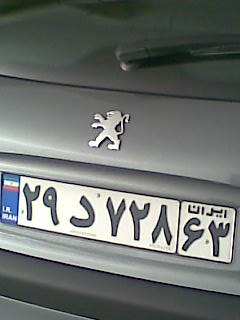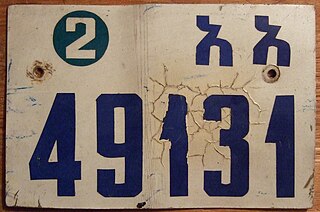Eritrea requires its residents to register their motor vehicles and display vehicle registration plates . [1]
| Image | First issued | Design | Slogan | Serial format | Serials issued | Notes |
|---|---|---|---|---|---|---|
 | ||||||
Eritrea requires its residents to register their motor vehicles and display vehicle registration plates . [1]
| Image | First issued | Design | Slogan | Serial format | Serials issued | Notes |
|---|---|---|---|---|---|---|
 | ||||||
The very first Italian registration plates, from 1913 to the end of the 1920s, were rectangular, with a white background and with the name or initials of the colony in red followed by the registration number, on a single line, but the documentation on this is fragmentary. For the Italian colonial troops, however, special military service plates were used with the initials SOM (Somalia) or T (Tripolitania) in front. Subsequently, until 1935, the Italian colonies used white plates on black with a colonial code on the first line, and up to 5 numbers on the second line. The numbers, in relief, were assigned serially and the plates were made of metal, with the fasces as a seal. The colonial codes were:
Between 1937 and 1941 there was an Italian governorate in Ethiopia and in those years a new type of Italian license plate was issued. They were exactly the same as the previous ones, but they had three squares on the left, colored top to bottom green, white and red, like the Italian flag, with the letters AOI (Africa Orientale Italiana) for Italian East Africa inside. The front plates resembled standard Italian front license plates, as these were smaller, and only sometimes had the colored squares like the rear license plates. [2] The abbreviations used to indicate the origin are:

A vehicle registration plate, also known as a number plate, license plate, or licence plate, is a metal or plastic plate attached to a motor vehicle or trailer for official identification purposes. All countries require registration plates for road vehicles such as cars, trucks, and motorcycles. Whether they are required for other vehicles, such as bicycles, boats, or tractors, may vary by jurisdiction. The registration identifier is a numeric or alphanumeric ID that uniquely identifies the vehicle or vehicle owner within the issuing region's vehicle register. In some countries, the identifier is unique within the entire country, while in others it is unique within a state or province. Whether the identifier is associated with a vehicle or a person also varies by issuing agency. There are also electronic license plates.

All motorized vehicles including motorcycles in Indonesia are required to have registration plates. The plates is required to be displayed in front and at the back of the vehicles. The issuing of the number plates is regulated and administered by the One-stop Administration Services Office or Samsat, which is a collaboration between Indonesian National Police, provincial offices of regional revenue, and the national mandatory vehicle insurance operator Jasa Raharja.
The most common format for vehicle registration plates in Romania consists of black letters on white background in the format CC 123 ABC, where CC is a one- or two-letter county code, 123 is a two- or three-digit group, and ABC is a three-letter group. The left side of the plate bears a blue vertical strip displaying the 12 stars of the European Union and the country code of Romania (RO). Between 1992-2007 the band featured the Romanian flag instead of the 12 stars. All lettering comes from the Latin alphabet.
Present Italian car number plates have black characters on a rectangular white background, with small blue side-fields. The current numbering scheme, in use from 1994, is unrelated to the geographical provenance of the car. By law, Italian plates can only be made by the Istituto Poligrafico e Zecca dello Stato and issued by local departments of motor vehicles.
In Albania, vehicle registration plates are issued by the regional directorates of transport.
Since Ukraine's independence in 1991, the country has used four main systems of vehicle registration plates.
Thailand's vehicle registration plates are issued by the Department of Land Transport (DLT) of the Ministry of Transport. They must be displayed on all motorized road vehicles, as required by the Motor Vehicle Act, B.E. 2522 and the Land Transport Act, B.E. 2522. The plates vary in design, colors and dimensions according to the type of vehicle, but usually display a registration number and the vehicle's province of registration. Specifications are given in Ministry of Transport regulations. Current style started in 1975 for most vehicle types, but with small changes in 1997, and 1997 for motorcycles
Vehicle registration plates of Estonia are divided into 18 categories, the most common of these (A1) is composed of three numbers and three letters. Most registration plate types have black letters on a white background, and the plates are the same size and length as other European plates. Previously the first of the three letters indicated the region of Estonia in which the car was registered; however, as of 2013, this is no longer the case. The third digit from the numbers indicated states when the car is due an inspection. It can be inspected up to 2 months after that digit. The registration plates are printed on an aluminium sheet with minimum thickness of 1 mm and must fulfil the requirements of ISO 7591:1982. All plates are issued with the blue European Union identification label, except types A9 and B2.

Vehicle registration plates of Latvia consist of two letters, a hyphen and one to four numbers (depending on the age of registration), e.g., AB-1234,
Vehicle registration plates of Georgia are composed of an embossed serial of two letters, a hyphen, three numbers, a hyphen, and two letters, in black on a white background with a blue vertical strip on the left. The plates are issued in the Latin alphabet. Georgian registration plates are the same size as the most common European registration plate. All plates have the abbreviation "GE" in the lower left corner of the plate and the national flag in the upper left corner. This set of new style registration plates have been in use since 1 September 2014.
The vehicle registration plates of Cyprus are composed of three letters and three digits. A simple incremental numbering system is used; numbers run from 001 to 999 per letter sequence (alphabetic), so that, for example, the plate to be issued after MAA 999 would be MAB 001. However, registrants may be allowed to choose a number from available numbers in the extant letter sequence.
An Israeli vehicle registration plate, or an Israeli license plate, is a vehicle registration plate, a metal or plastic plate or plates attached to a motor vehicle or trailer, used in Israel for official identification purposes.

Iranian license plates have had European standard dimensions since 2005. Each province in Iran has multiple unique, two-digit codes that are included at the right end of the license plates in a distinguished square outline, above which the word ایران or "Iran" has been written. A province's license plates will not be issued with a new code unless all possible combinations with the old code have been issued. In Tehran, the first code to be issued for the province was code 11, and subsequent codes all increased by 11 as well Ever since code 99 was fully issued, the new codes for Tehran have started from 10 and subsequently increased by 10. Most province codes increased by 10 based on the first code issued for their province. Khuzestan Province, for example, has been allocated codes 24 & 14, and code 24 will not be used before code 14 is fully issued. However, as codes started getting exhausted, numbers and letters have been assigned more liberally and without following this rule of thumb anymore

Vehicle registration plates of Vietnam generally take the form DDL-DDDDD for vehicles. Standard license plates have black characters on white background. Front plates measure 47 × 11 cm, rear ones are 27 × 20. The current scheme for civilian vehicles omits the letters I, J, O, Q and W, with the letter R reserved for trailers, and includes the Vietnamese Đ.

The Royal Corps of Colonial Troops was a corps of the Italian Armed Forces, in which all the Italian colonial troops were grouped until the end of World War II in Africa.
In Nepal, all road vehicles with or without a motor are tagged with a registration number. Licence plates are commonly known as number plates. The licence plate number is issued by the state-level Transport Management Office, a government agency under the Department of Transport Management. The licence plates must be placed in the front as well as back of the vehicle. The international vehicle registration code for Nepal is NEP.
Algerian registration plates are manufactured according to the same standards as their French counterparts, using the same font and dimensions – although there has been a recent tendency to apply custom typefaces.

Ethiopia requires its residents to register their motor vehicles and display vehicle registration plates. Current plates feature Ge'ez text.

Libya requires its residents to register their motor vehicles and display vehicle registration plates. Current plates are European standard 520 mm × 110 mm.

Somalia requires its residents to register their motor vehicles and display vehicle registration plates.